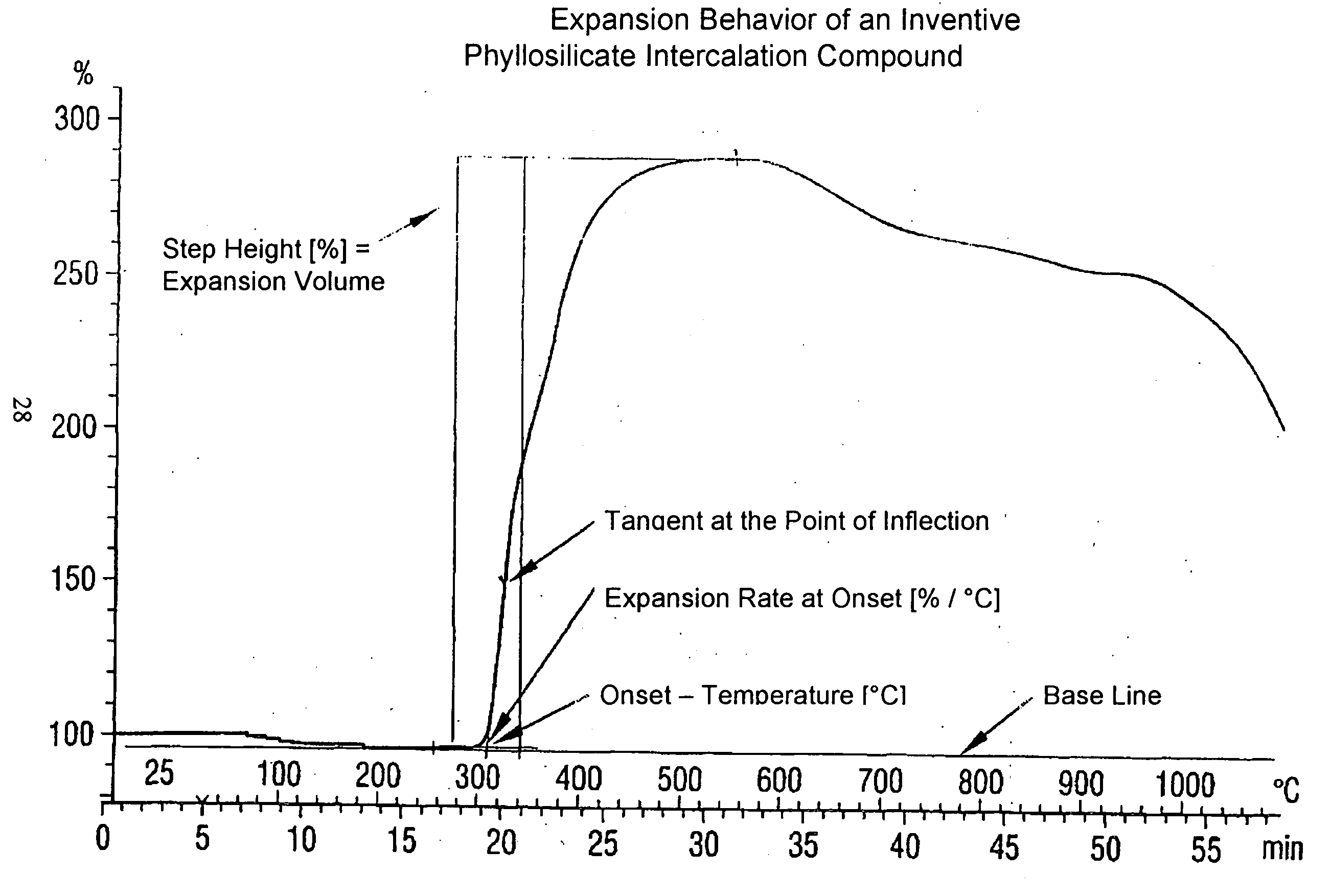Phyllosilicate-intercalation compounds with increased expansion volume, method for their synthesis and their use
a technology of expansion volume and compound, applied in the direction of detergent compounding agent, silicon compound, inorganic non-surface active detergent composition, etc., can solve the problems of limited passive fire protection use of these materials, insufficiently achieved flexibility, and insufficient matching of flame retardant, etc., to achieve the effect of increasing the expansion volume and higher the variability of intumescing materials
- Summary
- Abstract
- Description
- Claims
- Application Information
AI Technical Summary
Benefits of technology
Problems solved by technology
Method used
Image
Examples
example 2
[0046] Intercalation of sodium acetate by cation exchange in native, expandable vermiculite.
[0047] Native vermiculite (3 g, 0.05 moles) is placed in a 100 mL beaker and treated with stirring with an aqueous solution of 0.1 moles / L=5.0 moles / L of sodium acetate in solution in 30 mL of water. This reaction mixture is allowed to stand for three days at room temperature. It is then worked up by filtering the suspension through a glass filter with a pore size of G1 and washed with 100 mL of water in portions. Subsequently, the cation-exchanged vermiculite is dried for 12 hours at 60.degree. C. in a drying oven. The material is stable for months.
[0048] The determination of the expansion behavior in the manner described above shows that the vermiculite-intercalation compound, obtained in this way, has an onset temperature of 277.degree. C., a standardized expansion volume of 16.3 (% / mg) and an expansion rate of 16.4 (% / .degree. C.).
example 3
[0049] The intercalate compounds, given in the following Table 1, were intercalated in the expandable vermiculite by cation exchange in the Way described in Example of 2. The expansion properties of the vermiculite-intercalation compounds obtained are also summarized in the following Table.
2TABLE Ex- pansion Onset Stan- Tem- dard- per- ized Expansion ature Volume Rate Host Type Intercalate [.degree. C.] [% / mg] [% / .degree. C.] Native Vermiculite --(Comparison) 320 14.8 4.2 Native Vermiculite Dipotassium EDTA 235 20.8 17.2 Native Vermiculite Potassium gluconate 242 21.4 14.5 Native Vermiculite Potassium oxalate 244 19.0 21.8 Native Vermiculite Potassium acetate 248 20.8 18.6 Native Vermiculite Potassium formate 252 19.2 17.9 Native Vermiculite Sodium acetate 277 16.3 16.4 Native Vermiculite Sodium gluconate 297 18.0 17.4 Native Vermiculite Lithium citrate 347 20.4 16.2 Native Vermiculite Lithium acetate 349 18.8 7.9 Native Vermiculite Sodium propylate 356 17.4 23.7 Native Vermiculite ...
PUM
| Property | Measurement | Unit |
|---|---|---|
| average particle diameter | aaaaa | aaaaa |
| average particle diameter | aaaaa | aaaaa |
| temperature | aaaaa | aaaaa |
Abstract
Description
Claims
Application Information
 Login to View More
Login to View More - R&D
- Intellectual Property
- Life Sciences
- Materials
- Tech Scout
- Unparalleled Data Quality
- Higher Quality Content
- 60% Fewer Hallucinations
Browse by: Latest US Patents, China's latest patents, Technical Efficacy Thesaurus, Application Domain, Technology Topic, Popular Technical Reports.
© 2025 PatSnap. All rights reserved.Legal|Privacy policy|Modern Slavery Act Transparency Statement|Sitemap|About US| Contact US: help@patsnap.com


